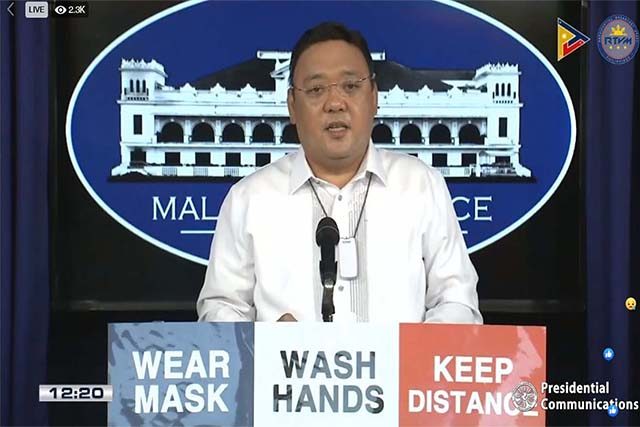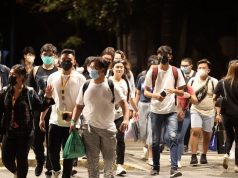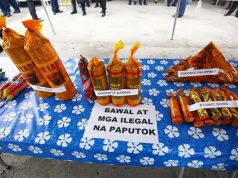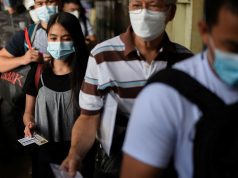
(UPDATED 3:07 p.m.) The 85% passing grade the Duterte government gave itself for its pandemic response did not consider the perceived gaps in health-oriented solutions during the six-month-long community quarantine.
At a press briefing on Tuesday, September 15, when a reporter asked for an assessment or “grading” of the national government’s response to the novel coronavirus pandemic, presidential spokesperson Harry Roque responded that he would give it a “very good grade” of 85.
“All in all, I think we deserve a very good grade. I would give it a grade of 85%,” Roque said.
He also claimed that the Philippines’ testing capabilities are the “best” in Asia and the world despite delayed mass testing efforts during the past tough lockdowns.
“We clearly have the best testing policy in the whole of Asia and probably in the whole world because we have exceeded three million and as a percentage of total population, ano na po iyan, lubus-lubusan na po iyan doon sa sinasabi nilang 3% na dapat na ma-test ang population at patuloy pa po tayo ‘no,” Roque said.
“So, dadami po tayo and I think we will have the highest number of testing, one of the highest in the whole world. So, that’s clearly, our biggest strength,” he added.
There’s no worldwide benchmark for testing policies to detect the new pathogen. In terms of the testing capacity, the Philippines only started to ramp up its testing efforts last May and not all of these are government-sponsored.
In an interview with ABS-CBN news, UP-OCTA Research fellow Fr. Nicanor Austriaco said that “many of the countries especially in north Asia, have had such robust testing and contact tracing protocols that their pandemics never really exploded in the way that ours did in July.”
“We are testing so much, and yet the total number of cases is quite high here in the Philippines, sadly,” he added.
It’s only last August when the Department of Health increased an average daily testing capacity of 27,800 and addressed its data backlog woes.
As of August 6, the DOH said there are a total of 100 licensed testing laboratories throughout the Philippines who are eligible to conduct RT-PCR (Reverse transcription polymerase chain reaction) testing for the diagnosis of COVID-19
Roque and Health Secretary Francisco Duque III previously claimed that the term “mass testing” involves the entire population of the Philippines.
Since last March, groups of local scientists, medical workers and health advocates have defined “mass testing” as detecting the deadly virus which causes COVID-19 in vulnerable or high-risk communities or sectors such as front line health workers and suspected infections.
Following these remarks, critics took to Twitter to express their dismay over the high rating amid the continued rise of cases and deaths.
“best testing policy in the whole of Asia and probably in the whole world” pic.twitter.com/Vzx36A3c3j
— edsa ⁷ (@pajpatatas) September 15, 2020

Some Twitter users, meanwhile, poked fun at the six-month community quarantine of the country, which is among the longest in the world.
“Six months na pala tayong naka quarantine iniwan na tayo’t lahat lahat, naka tatlong batch ka na ng kalandian, nakatapos ka na ng ilang series at nakailang iyak ka na pero ang tanong kelan ba to matatapos,” Twitter user Mark Geronimo said.
“Congratulations, regular na tayo! Anim na buwan na tayong naka-community quarantine. Sana makatanggap na tayo ng tunay na benepisyong medikal at makataong social safety nets,” another user wrote.
Others were more straightforward in expressing their disappointment and frustration.
“Longest lockdown, poorest response, misplaced priorities. It’s been six freakin’ months,” Twitter user Kerwin King said.
The Philippines’ community quarantines
It was on March 16 when President Rodrigo Duterte imposed the enhanced community quarantine in Luzon and other parts of the country to supposedly curb the spread of COVID-19.
This form of lockdown suspended all onsite classes and work, operations of mass transport and only those who work in industry considered essential by the Inter-Agency Task Force for the Management of Emerging Infectious Diseases (IATF-EID) are allowed to go outside.
These include all health workers, employees in the food and beverage businesses, and military and security personnel.
ECQ had been extended three times. However, the third implementation, which was from April 24 to May 15, only covered Metro Manila and other regions that have higher number of COVID-19 cases.
Others, meanwhile, have shifted to general community quarantine, a relaxed version of the quarantine phase.
Different parts of the Philippines eventually transitioned from ECQ to its modified version, and then to GCQ and the modified phase.
As of writing, Mega Manila is still in GCQ and the rest are in MGCQ.
Contact tracing czar Baguio Mayor Benjamin Magalong said only 1% of the local government units assigned to conduct contact tracing have a “relatively good” system.
READ: The DOH has no contact tracing team. Here’s why.
It was only last September 14 when the Department of Interior and Local Government started to hire contact tracers to reach its target of 150,000 personnel despite having this goal since June.









